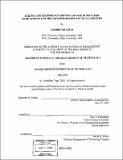Science and technology driving change in drug R&D : some lessons for the Japanese pharmaceutical industry
Author(s)
Togo, Yoshifumi, 1967-
DownloadFull printable version (6.110Mb)
Alternative title
Science and technology driving change in drug research and development
Other Contributors
Management of Technology Program.
Advisor
Stan N. Finkelstein.
Terms of use
Metadata
Show full item recordAbstract
The technology platform in the research and development of pharmaceutical drugs is changing dramatically -- from the traditional trial-and-error method to modem sophisticated methods that use Combinatorial Chemistry (CC), High Throughput Screening (HTS), and Gene Technology. Since the beginning of the 1990s, pharmaceutical companies have actively invested into such technologies. Some investment has been in-house, but many companies have acquired high-tech ventures or formed strategic alliances. Today it is necessary for every firm to make the best use of all these technologies in order to improve their R&D productivity. However, it is expensive to use all of them. Over the past five years, many leading global companies have begun to merge. There are various reasons for merging, but the most common is to enhance R&D activity and marketing by reducing redundancy and reinvesting the savings. These attitudes indicate that the critical mass of the industry will increase rapidly. Similar technological change is occurring in Japan. In addition, other changes in the Japanese pharmaceutical industry are also having a significant effect, such as the national health insurance system and the R&D regulatory environment. However, compared to the magnitude of radical change among global companies, much less has occurred in the Japanese industry. That is, fewer mergers have occurred between leading Japanese pharmaceutical companies. Instead, Japanese companies seem to be mired in a dilemma in a rapidly changing environment. To break through this situation, Japanese pharmaceutical companies must consider making some deals. I analyzed the R&D strategies of five pharmaceutical companies, to learn how they acquire genetic technology strategy, and I found some interesting points. The research found that increasing the critical mass of the industry through M&As and strategic alliances, coupled with excellent strategies and effective R&D management, is indispensable for the industry as a whole, specifically for medium-sized firms. Finally, I conclude with some specific recommendations for Welfide Corporation, as it seeks to solve the dilemmas and enter the global markets of the pharmaceutical industry.
Description
Thesis (S.M.M.O.T.)--Massachusetts Institute of Technology, Sloan School of Management, Management of Technology Program, 2000. Also available online at the MIT Theses Online homepage <http://thesis.mit.edu>. Includes bibliographical references (p. 99-101).
Date issued
2000URI
http://theses.mit.edu/Dienst/UI/2.0/Describe/0018.mit.theses%2f2000-111http://hdl.handle.net/1721.1/9231
Department
Management of Technology Program.; Sloan School of ManagementPublisher
Massachusetts Institute of Technology
Keywords
Management of Technology Program.